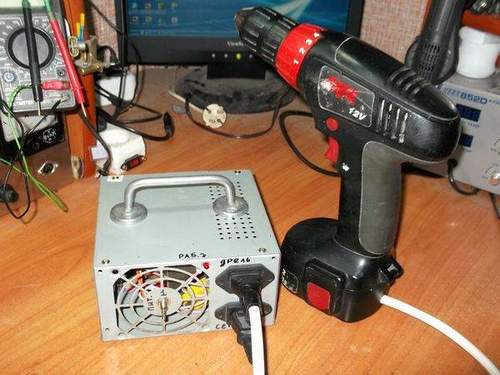
A cordless screwdriver is undoubtedly a useful tool, the main advantage of which is mobility. But when the native batteries completely or partially die, buying new ones results in a tidy sum, comparable to half the cost of a new tool. Many just buy a new screwdriver, but I suggest, due to the loss of mobility, to make a reliable power source for it, which will permanently remove the problem of constant charging of half-dead batteries.
Let’s look at the pros and cons of such modernization
Let’s start with the cons. The biggest and only problem is the wire binding of the screwdriver to the socket, which is more than blocked by the following pluses:
- The screwdriver is always ready to work, the problem of uncharged batteries (or not running out of time) disappears.
- It feels great in an environment of low and freezing temperatures, unlike a battery.
- If native batteries are dead, and a toad strangles buying new ones, then the power supply completely replaces the batteries.
If you are comfortable with these conditions, then let’s get started!
The power supply can be made pulse or transformer. Why I settled on the transformer version, it will be clear in the course of reading the article. If your screwdriver runs on 12 or 14 volts, then I advise you to stop precisely on a switching power supply from a computer. This option requires a minimum of alteration and costs.
Patient No. 1
Reason for modernization: The batteries run out quickly, even then, when they were new.
The purpose of modernization: Get a hybrid powered by batteries and mains.
For power, a current of about 10A is needed. Here the question arises of using a computer power supply, but here’s the problem. the screwdriver works from 18v. When applying to it, 12v twists very sluggishly and can be braked by hand with almost no effort. Although some argue that a screwdriver normally turns from 12 volts, but now, so to speak, the myth is verified and destroyed.
There are 2 options left. to redo the PWM control of the pulse block so that it gives out the right voltage, or use a transformer with the right voltage.
Another drawback of the switching power supply is that it is designed to work at room temperature, and it is not known how it will behave at a lower temperature. In principle, a transformer practically does not care in what conditions it is operated. Although these are all assumptions that have not been tested in practice.
A powerful 18 volt transformer is quite difficult to find, but for me it has become impossible. At this point, I wanted to return to the option with a computer power supply, but suddenly, as the masters of the 7th grade say, a toroidal transformer with a primary winding wound accidentally fell into my hands. It remains only to wind the secondary, I got about 90 turns of wire 1.5.
Video: Which Power Supply For A Screwdriver Instead Of A Battery
If you decide rewind the transformer to another voltage, then the program will help you Power Trans.
The power supply is made in the housing of the AT unit. The role of the rectifier is played by 10 ampere Schottky diodes, connected by a bridge circuit. 220 goes to the native connector of the unit, 18v goes from the connector intended for connecting the monitor. The toggle switch is turning off the power, and the LED indicates the presence of 18v.
For convenience in operation and carrying, the unit is equipped with a folding handle:
Since I need a hybrid, I had to bring out a separate fishing line for connecting the unit:
In this case, do not forget to disconnect the batteries when working from the unit.
Taking the opportunity, when disassembling a screwdriver, added the highlight of the working area:
The result was such a mutant:
Patient No. 2
Reason for modernization: The native battery has died, recovery is not justified.
The purpose of modernization: Replace battery with power supply.
Here I came across a 12-volt unit, and I connected it to a computer power supply. But it wasn’t chickpeas. the block began to leave in defense. Connected it to a more powerful PSU, the picture has not changed. The reason for this was the short-circuited motor winding. The brushes of the engine turned out to be quite large, and I decided to make a transformer power supply, there is no protection in it. In any case, the engine will run for a while, and then it can be replaced (perfectly suited from other screwdrivers and automobile pumps).
Here, a UPS transformer came in handy for me, successfully lying under my desk for half a dozen years, waiting for its finest hour. Just under the desired 12v.
Everything is assembled according to the same principle, but instead of the Schottky diodes, I used 3 Schottky diode assemblies extracted from computer power supplies.
In the previous block, I used a whole cord to connect the monitor, but do not do this. The cross section of the native cord is small and causes heat and loss. It is more correct to use only the connector. I soldered to it a two-core PVA 2.5 squares:
It is better not to use a very long low-voltage cord, there will be losses. It is better to make the power cord longer.
He took out the cans from the battery case and connected the power: